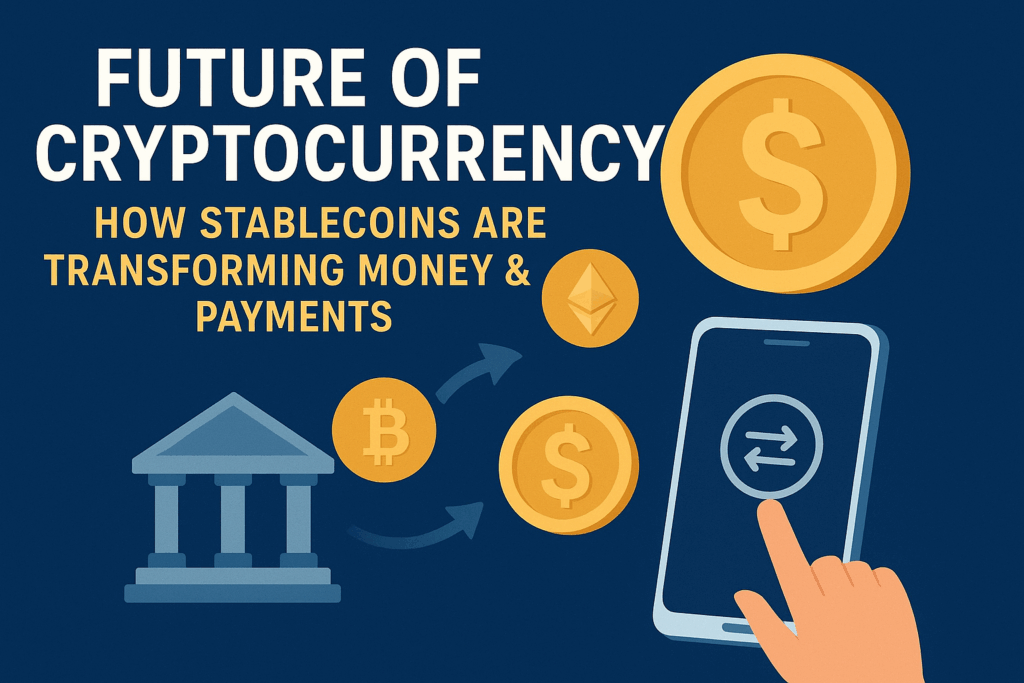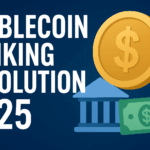Introduction: The Turning Point for Digital Money
What comes to mind when you hear cryptocurrency? For many, it’s Bitcoin’s volatility, Ethereum’s smart contracts, or the rollercoaster stories of investors gaining and losing fortunes overnight. But in 2025, a quieter yet more revolutionary force is shaping the future of cryptocurrency: stablecoins.
Unlike their volatile cousins, stablecoins are pegged to stable assets like the U.S. dollar, euro, or even gold. This makes them less about speculation and more about usability. They are becoming the bridge between traditional finance and the digital economy, reshaping how we pay, save, and move money globally.
And if you’re wondering whether this shift is temporary hype or the real deal, let’s dive into the numbers, insights, and what’s happening on the ground.
Why Stablecoins Are at the Heart of the Future of Cryptocurrency
The crypto industry has long struggled with one big issue: volatility. Imagine trying to pay rent in Bitcoin, only to have its value drop 15% overnight. That’s where stablecoins shine.
- Pegged to Stability: Most stablecoins are backed 1:1 with reserves like USD (e.g., USDC, USDT).
- Global Liquidity: They move across borders faster than traditional money transfers.
- Everyday Use Cases: Payments, remittances, payroll, lending, and even online shopping.
According to a Circle report, stablecoin transactions in 2024 already surpassed $9 trillion, rivaling the volume of major card networks. That’s not just a financial trend—it’s a paradigm shift.
Stablecoins vs. Traditional Banking
Let’s break it down simply.
📊 Comparison Table: Stablecoins vs. Traditional Banking
| Feature | Stablecoins | Traditional Banking |
| Transaction Speed | Seconds to minutes | 1–3 business days |
| Fees | Near zero to <1% | 2–10% for cross-border |
| Availability | 24/7, global | Limited to banking hours |
| Transparency | Blockchain ledger | Centralized records |
| Accessibility | Anyone with internet | Requires bank account |
This comparison highlights why stablecoins are increasingly seen as the “digital dollar of the internet.”
Real-World Adoption: More Than Just Tech Hype
One of the most fascinating aspects of stablecoins is how quickly they’ve moved from niche crypto circles into mainstream finance:
- PayPal and Visa now support stablecoin payments, letting people pay merchants directly.
- Latin America & Africa are adopting stablecoins for remittances, bypassing high bank fees.
- Freelancers and digital nomads increasingly prefer stablecoin salaries because they’re fast and borderless.
As someone who freelances internationally, I’ve seen this first-hand. Clients who once paid me through PayPal or wire transfers (with delays and fees) now send USDC directly to my wallet—and I can access it instantly. That kind of efficiency changes how you view money.
Stablecoin Regulation in 2025: The Trust Factor
One big question is: Can we trust stablecoins?
The 2022 collapse of TerraUSD reminded the world that not all stablecoins are created equal. In response, countries are tightening rules:
- USA: The Stablecoin TRUST Act requires issuers to maintain 100% reserves.
- UK & EU: Introducing frameworks for euro-backed stablecoins tied to licensed banks.
- France: Working on euro stablecoins for e-commerce adoption.
- Australia & Canada: Exploring stablecoin pilots for cross-border trade.
This regulatory clarity is crucial. It separates speculative projects from legitimate financial tools that banks, businesses, and individuals can rely on.
Stablecoins and the Broader Future of Cryptocurrency
Stablecoins aren’t here to kill Bitcoin or Ethereum—they’re complementing them. Here’s how:
- Bitcoin = Digital Gold (store of value).
- Ethereum = Smart Contracts (decentralized applications).
- Stablecoins = Digital Money (daily payments).
In this way, stablecoins act as the “spending layer” of crypto, while other cryptocurrencies remain investment or infrastructure assets.
Key Opportunities Ahead
So, where are stablecoins headed in the future of cryptocurrency?
1.
Global Payments & Remittances
Stablecoins will eat into the $700B remittance market dominated by companies like Western Union.
2.
Decentralized Finance (DeFi)
From stablecoin-backed loans to high-yield savings accounts, stablecoins will be the backbone of DeFi.
3.
Business Payments
Cross-border trade will increasingly rely on stablecoins for instant settlement and lower risk.
4.
Everyday Banking
Banks may not be replaced but will adapt, offering stablecoin accounts or integrating stablecoin payments into mobile apps.
Our Related Topics
Stable Coins Banking Revolution 2025
How To Build Passive Income In 2025
Personal Finance & Crypto Investing
FAQs: Future of Cryptocurrency & Stablecoins
1. What is the future of cryptocurrency in 2025 and beyond?
The future of cryptocurrency is shifting from speculation to utility. Stablecoins are leading this by enabling real-world payments, remittances, and banking services.
2. Are stablecoins safer than Bitcoin?
Stablecoins are less volatile because they’re pegged to stable assets like the U.S. dollar. However, their safety depends on issuer transparency and regulation.
3. Can stablecoins replace banks?
Not entirely. Banks will adapt by partnering with stablecoin issuers or launching digital currency services of their own.
4. How are stablecoins used in real life?
Freelancer payments, remittances, e-commerce, cross-border trade, and even everyday purchases are being powered by stablecoins.
5. Which countries are leading stablecoin adoption?
The USA, UK, Canada, Australia, and France are leading, but developing economies are adopting stablecoins faster due to high remittance demand.
Conclusion: Stablecoins as the Bridge to the Future of Cryptocurrency
The future of cryptocurrency is not just about volatile assets or speculative trading—it’s about building a new financial system that works better than the old one. Stablecoins are at the heart of this shift.
They’re making money faster, cheaper, and more accessible, while regulators bring much-needed trust. For individuals, freelancers, and businesses, this means payments that feel as easy as sending an email.
The revolution isn’t years away—it’s happening now. And if you’re not paying attention to stablecoins, you might be missing the biggest financial transformation of our time.
🚀 Call-to-Action
What do you think?
- Would you accept your salary in stablecoins?
- Do you trust them more than traditional banks?
👉 Share your thoughts in the comments below, explore our guide on digital banking trends, and subscribe to stay ahead of the curve in the future of cryptocurrency.




